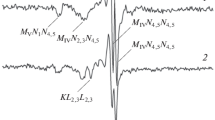Abstract
Nickel (Ni+) ions of 180 keV energy impinging on {100} faces of nickel single crystals produce sputtered surfaces. Examination of these surfaces exposed to fluences up to 8 X 1017 ions/cm2 and at temperatures between 25 °C and 750 °C reveals pits with facets parallel to the {111} and {100} crystallographic planes of the nickel. Subsurface voids also form and, when intersected by the sputtered surface, become small pits which grow with further sputtering. The pits exhibit facets that are direct extensions of facets present on the voids. The voids nucleate and grow during the initial stages of bombardment at temperatures above 600 °C but shrink beyond fluences of ~3.5 X 1017 ions/cm2. Voids are not observed after bombardment at temperatures less than 600 °C. Sputtering at these lower temperatures produces no pits unless the nickel is bombarded first at higher temperatures to produce the requisite voids. Measuring the rate at which the {100} surface recedes due to sputtering provides the sputtering yield. This yield, near 3.8 atoms per Ni+ ion, is independent of temperature from 25 °C to 750 °C. The growth rate of the pits,i.e., the rate at which oppositely inclined {111} faces separate, is also measured. At temperatures below 350 °C, the measured growth rate matches that based on sputtering of these inclined surfaces. The rate increases with increasing temperature above 350 °C, reaching nearly tenfold its low-temperature value by 750 °C. The mechanisms causing this accelerated growth with increasing temperature are discussed and related to the migration of the point defects produced by the bombardment.
Similar content being viewed by others
References
N. Taniguchi:Precision Eng., 1994, vol. 16, pp. 5–24.
I. Miyamoto:Precision Eng., 1987, vol. 9, pp. 71–76.
G. Carter, M.J. Nobes, I.V. Katardjiev, and J.L. Whitton:Defect Diff. Forum, 1988, vols. 57–58, pp. 97–126.
P. Sioshansi:Nucl. Inst. Meth. Phys. Res., 1987, vols. B19–B20, pp. 204–08.
B.A. Banks: inIon Bombardment Modification of Surfaces, O. Auciello and R. Kelly, eds., Elsevier Science Publishing, New York, NY, 1984, pp. 399–462.
H.A. Plain:Precision Engineering in the Generation of Aspheric Surfaces, Eastman Kodak Company, Rochester, NY, 1987.
M. Ahmed, K. Ruffing, and D.I. Potter:Mater. Sci. Eng., 1987, vol. 90, pp. 37–43.
M. Ahmed and D.I. Potter:Acta Metall., 1985, vol. 33, pp. 2221–31 ; 1987, vol. 35, pp. 2341-54.
J.K. Steele and D.I. Potter:J. Nucl. Mater., 1995, vol. 218, pp. 95–107.
J.K. Steele, C.H. Koch, and D.I. Potter:Surf. Coat. Technol, 1992, vol. 51, pp. 399–404.
J.K. Steele: Ph.D. Thesis, University of Connecticut, Storrs, CT, 1994.
O. Almen and G. Bruce:Nucl Inst. Meth., 1961, vol. 11, pp. 257–78.
J.A. Hudson, D.J. Mazey, and R.S. Nelson:J. Nucl. Mater., 1971, vol. 41, pp. 241–56.
R. Sigmund:Phys. Rev., 1969, vol. 184, pp. 383–416.
R.S. Nelson:Phil. Mag., 1965, vol. 11, pp. 241–302.
G.E. Chapman, B.W. Farmery, and M.W. Thompson:Rad. Effects, 1972, vol. 13, pp. 121–29.
K. Besocke, S. Berger, W.O. Hofer, and U. Littmark:Rad. Effects, 1982, vol. 66, pp. 35–41.
R. Kelly:Surf. Sci., 1979, vol. 90, pp. 280–319.
H. Wiedersich:Rad. Effects, 1972, vol. 12, pp. 111–25.
A.D. Brailsford and R. Bullough:J. Nucl. Mater., 1972, vol. 44, pp. 121–35.
L. Mansur: inKinetics of Nonhomogeneous Processes, G.R. Freeman, ed., John Wiley and Sons, Inc., New York, NY, 1987, pp. 377–463.
J.A. Sprague, J.E. Westmoreland, F.A. Smidt, Jr., and P.R. Malmberg:J. Nucl. Mater., 1974, vol. 54, pp. 286–98.
N.H. Packan, K. Farrell, and J.O. Steigler:J. Nucl. Mater., 1978, vol. 78, pp. 143–55.
M. Kiritani and H. Takata:J. Nucl. Mater., 1977, vols. 69–70, pp. 277–309.
R.T. Tung and W.R. Graham:Surf. Sci., 1980, vol. 97, pp. 73–87.
T. Michely, K.H. Besocke, and G. Comsa:Surf. Sci. Lett., 1990, vol. 230, pp. L135-L139.
T. Michely and G. Comsa:Surf Sci., 1991, vol. 256, pp. 217–26.
Author information
Authors and Affiliations
Additional information
Formerly Visiting Scientist, Metallurgy Department, University of Connecticut
Rights and permissions
About this article
Cite this article
Steele, J.K., Potter, D.I. Sputter-induced pits on {100} nickel surfaces. Metall Mater Trans A 27, 981–993 (1996). https://doi.org/10.1007/BF02649766
Received:
Issue Date:
DOI: https://doi.org/10.1007/BF02649766




